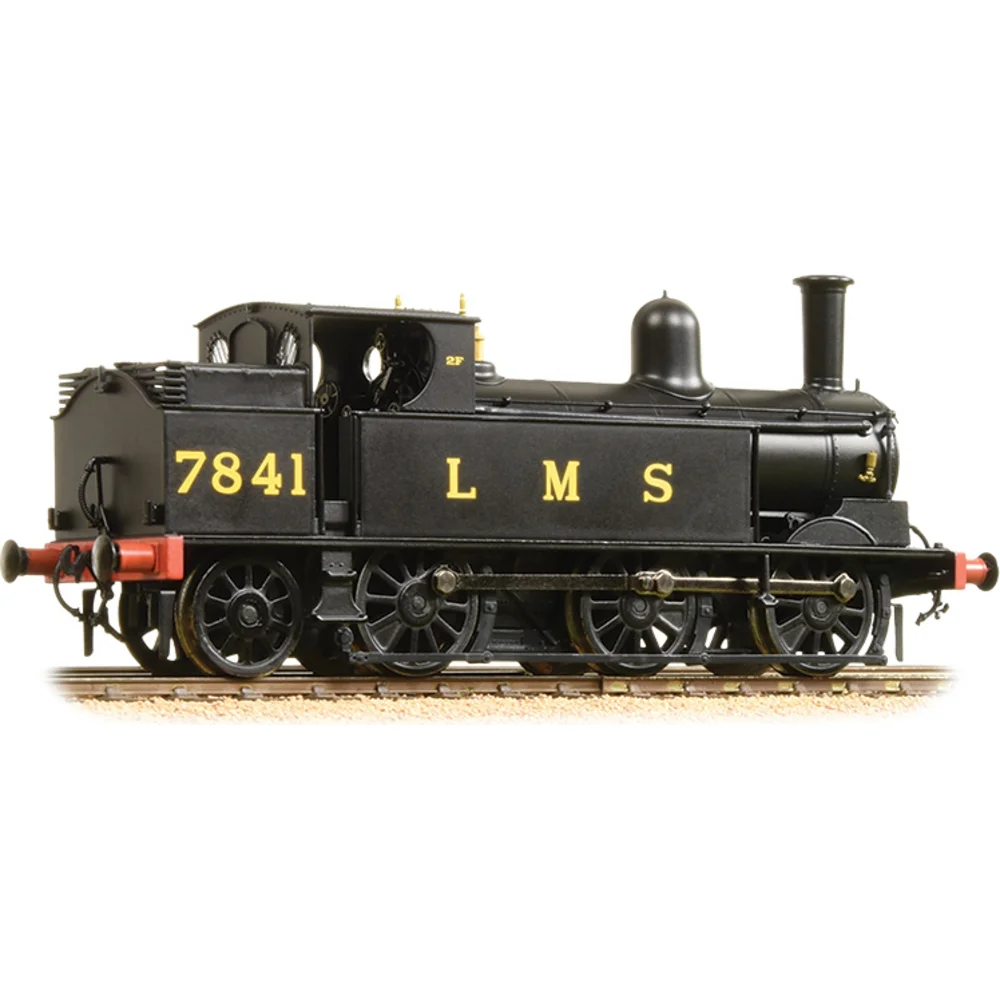Bachmann 35-051
London & North Western Railway Webb Coal Tank 7841 London, Midland & Scottish Railway Black
Tooling
Bachmann’s OO gauge Webb Coal Tank filled a long-standing gap for late-Victorian LNWR tank engines in ready-to-run form. The model was announced following the high-profile return to steam of preserved No. 1054 and entered the range in 2017, with the project reported as being initiated around 2014. As a subject that largely predates the 1950s transition era, the Coal Tank signalled manufacturers’ growing interest in pre-Grouping locomotives that survived into later liveries, aided by the public appeal of the sole survivor.
Scale & Construction
The Coal Tank is a 1:76 scale OO gauge model using a mixed plastic/metal chassis for strength and weight, with a body festooned with separately applied details. The tooling captures hallmark features such as the narrow, tall tanks, inside valve gear (represented), and visible daylight between the frames.
Detailing
Factory detail includes coal rails, handrails, lamp irons, pipework and smokebox door dart; the cab is fully decorated. Era-specific fittings are catered for — LNWR versions carry Ramsbottom safety valves and LNWR-pattern lamp irons, whereas later LMS versions receive Ross Pop valves and LMS-pattern irons. Accessory packs provide bufferbeam detail and screw-link couplings for display.
Couplings
The model uses NEM coupling pockets with standard tension-lock couplers installed from the factory, with cosmetic coupling hooks and optional screw-link parts included.
Motor & Drive
A compact can motor drives the coupled axles; running is specified for curves down to 2nd radius (˜438 mm). Electrical pickup is from the driving wheels, matching typical practice for small OO steam locomotives.
Lighting
No factory-fitted lighting is listed in official or retailer specifications for this tooling.
Weighting & Finish
Adhesion is aided by weight built into the chassis; the wheel treads are chemically blackened for realism.
DCC Capability & Sound
The Coal Tank is DCC-ready using a Next18 interface (NEM662) on the main PCB. A purpose-made cavity beneath the PCB accepts a sugar-cube speaker of around 15 × 11 × 9 mm, enabling straightforward sound fitting without removing metal from the chassis. Enthusiast videos demonstrate decoder fitting to this model using Bachmann’s own Next18 decoder.
Liveries Produced from This Tooling
Initial releases covered:
- LNWR plain black (as preserved No. 1054)
- LMS black
- BR black with early emblem
These utilise the same core tooling with detail variations appropriate to each period.
Reviews, Media & Community Commentary
- Press: Model railway magazines praised the model’s pre-Grouping significance, the 2014 project origins tied to 1054’s return to steam, and the 2017 arrival in shops.
- YouTube: Multiple channels praised the fine detail and smooth slow-speed performance; videos also show straightforward Next18 decoder installation specific to this tooling.
- Sam’s Trains Review – “Bachmann Webb Coal Tank Engine | Unboxing & Review” – Unboxing, historical context, mechanism overview, and running performance.
- Little Wicket Railway – “Bachmann Ex-LNWR Webb Coal Tank (35-051) | Unboxing and Review” – Detailed look at LMS-liveried version, close-ups and running tests.
- Forums: Early community threads discussed minor points such as pickup wipers and the then-new Next18 interface supplanting 6-pin on small steam models; overall sentiment was positive about detail and running.
Other Notes & Interesting Details
The prototype history (1881–1897, 300 built; one preserved) underpins the breadth of liveries achievable from this tooling and explains its appeal beyond LNWR layouts. Retailer directories confirm the Branchline Coal Tank as a 2017-tooled model, aligning with Bachmann’s shift to compact Next18 interfaces on small steam subjects during that period.
Class & Prototype
- Class: London & North Western Railway Webb Coal Tank
- Traction: Steam
- Built: 1881-1897
- Total Built: 300
- Running Number: 7841
Operator & Livery
- Operator: London, Midland & Scottish Railway
- Livery: Black
- Era: 3 - The big 4 – LMS, GWR, LNER & SR
The London, Midland & Scottish Railway (LMS) was Britain's largest railway company from 1923-1948, formed by merging over 120 independent railways under the Railways Act 1921. Operating 7,790 route miles across England, Scotland, Wales, and Northern Ireland, the LMS became the world's largest transport organisation and the British Empire's biggest commercial enterprise. Famous for iconic locomotives like the streamlined Princess Coronation class, versatile Black Fives, and Royal Scots, the company evolved from inherited pre-grouping designs to revolutionary Stanier innovations. The LMS operated major routes including the West Coast Main Line from London Euston to Scotland, serving as the UK's second-largest employer after the Post Office. Nationalised in 1948 to form British Railways' London Midland Region, the LMS legacy continues through extensive preservation efforts and remains a favourite subject for railway modellers seeking authentic British steam-age prototypes.
The LMS plain black livery served as the standard finish for freight locomotives and represented practical railway economics during the company's existence. Applied without lining or embellishment, this utilitarian scheme recognised that goods engines operated in inherently dirty conditions where elaborate paintwork proved both expensive and impractical.
Most LMS freight classes including the ubiquitous 0-6-0 goods engines, 0-8-0 heavy freight locomotives, and tank engines used for shunting duties wore plain black throughout their service lives. The scheme extended beyond locomotives to goods wagons, where black paint provided adequate weather protection at minimal cost.
During World War II, plain black became increasingly common as material shortages and wartime economies forced the abandonment of more elaborate liveries. Even some passenger locomotives temporarily adopted unlined black finishes when crimson lake supplies became unavailable. The practical benefits of black paint - its ability to hide dirt, soot, and industrial grime - made it ideal for locomotives working coal trains, mineral traffic, and heavy industrial duties.
For modellers, plain black represents the workhorse reality of LMS operations, particularly appropriate for freight yards, colliery branches, and industrial settings where authentic weathering and operational realism take precedence over passenger train glamour.
